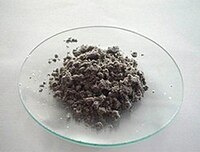Sodium hydride
 |
|
 |
|
| Identifiers | |
|---|---|
|
7646-69-7 |
|
| 3D model (Jmol) | Interactive image |
| ChemSpider |
23144 |
| ECHA InfoCard | 100.028.716 |
| EC Number | 231-587-3 |
| PubChem | 24758 |
|
|
|
|
| Properties | |
| NaH | |
| Molar mass | 23.99771 g/mol |
| Appearance | white or grey solid |
| Density | 1.396 g/cm3 |
| Melting point | 300 °C (572 °F; 573 K) decomposes |
| Reacts with water | |
| Solubility | insoluble in ammonia, benzene, CCl4, CS2 |
|
Refractive index (nD)
|
1.470 |
| Structure | |
| fcc (NaCl), cF8 | |
| Fm3m, No. 225 | |
|
a = 498 pm
|
|
| Octahedral (Na+) Octahedral (H−) |
|
| Thermochemistry | |
| 36.4 J/mol K | |
|
Std molar
entropy (S |
40 J·mol−1·K−1 |
|
Std enthalpy of
formation (ΔfH |
−56.4 kJ·mol−1 |
|
Gibbs free energy (ΔfG˚)
|
-33.5 kJ/mol |
| Hazards | |
| Safety data sheet | External MSDS |
| GHS pictograms |  |
| GHS signal word | DANGER |
| H260 | |
| NFPA 704 | |
| Flash point | combustible |
| Related compounds | |
|
Other cations
|
Lithium hydride Potassium hydride |
|
Related compounds
|
Sodium borohydride |
|
Except where otherwise noted, data are given for materials in their standard state (at 25 °C [77 °F], 100 kPa).
|
|
|
|
|
| Infobox references | |
Sodium hydride is the chemical compound with the empirical formula NaH. This alkali metal hydride is primarily used as a strong, yet combustible base in organic synthesis. NaH is representative of the saline hydrides, meaning it is a salt-like hydride, composed of Na+ and H− ions, in contrast to the more molecular hydrides such as borane, methane, ammonia and water. It is an ionic material that is insoluble in organic solvents (although soluble in molten Na), consistent with the fact that H− remains an unknown anion in solution. Because of the insolubility of NaH, all reactions involving NaH occur at the surface of the solid.
NaH is produced by the direct reaction of hydrogen and liquid sodium. Pure NaH is colorless, although samples generally appear grey. NaH is ca. 40% denser than Na (0.968 g/cm3).
NaH, like LiH, KH, RbH, and CsH, adopts the NaCl crystal structure. In this motif, each Na+ ion is surrounded by six H− centers in an octahedral geometry. The ionic radii of H− (146 pm in NaH) and F− (133 pm) are comparable, as judged by the Na−H and Na−F distances.
A very unusual situation occurs in a compound dubbed "inverse sodium hydride", which contains Na− and H+ ions. Na− is an alkalide, and this compound differs from ordinary sodium hydride in having a much higher energy content due to the net displacement of two electrons from hydrogen to sodium. A derivative of this "inverse sodium hydride" arises in the presence of the base adamanzane. This molecule irreversibly encapsulates the H+ and shields it from interaction with the alkalide Na−. Theoretical work has suggested that even an unprotected protonated tertiary amine complexed with the sodium alkalide might be metastable under certain solvent conditions, though the barrier to reaction would be small and finding a suitable solvent might be difficult.
...
Wikipedia

